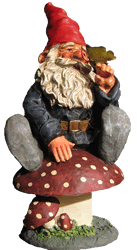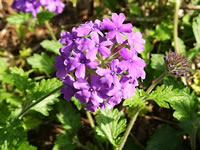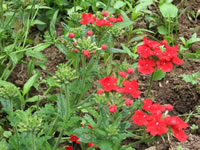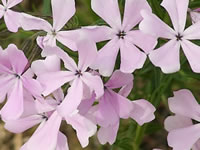Everything you Need to Know about Growing Verbena Plants
Verbena species
             
There are about 250 annual and perennial species of Verbena
but there are only about a half dozen that are commonly cultivated.
These easy to grow, long blooming plants are both heat and drought tolerant.
Some perennial Verbenas tend to be short lived due to their extended season of prolific blooms
that begins in their first year, so they are often grown as annual plants.
Typically, Verbena have narrow, lance shaped or deeply cut, green foliage growing on square or angular stems.
Trailing forms of Verbena are excellent for growing in containers and hanging baskets.
Different species of Verbena vary considerably in their size and structure.
Purpletop Verbena, Verbena bonariensis, is an erect, shrubby perennial that will grow to 6 ft. tall in southern regions, but only 3 ft. in the north. They produce 2"-3" rounded clusters of ¼", deep purple flowers from mid-summer through fall.
Self-seeds readily. Hardy in USDA zones 7-11.
Rose Verbena, Verbena canadensis, is a short lived, creeping perennial that is native to eastern North America.
Rose Verbenas grow from 6"-18" tall with a spread of 2-3 feet. In early summer, they produce a profusion of dense 2½" clusters of rose-pink flowers and will continue to bloom sporadically until the first frost, if deadheaded regularly. This self layering plant is Hardy in USDA zones 6-10.
|
 |
Common Garden Verbenas, Verbena x hybrida, are tender perennials that are usually grown from bedding plants as annuals. They may be erect and bushy, growing to 18" tall, or trailing 6" tall plants, depending on the cultivar. They produce dense clusters of brightly colored, fragrant, ½"-1" flowers from summer through fall, but blooming may decline as summer temperatures rise.
Hardy in USDA zones 9-10.
Moss Verbena, Verbena tenuisecta, is a ground hugging, evergreen perennial with deeply cut, aromatic foliage. They will grow 6"18" tall and is capable of spreading up to 5 feet wide. From late spring through the summer, they produce masses of tiny, Lilac colored flowers in tight, 3" clusters. Requires warm temperatures and fairly dry soil.
Hardy in USDA zones 9-11.
Swamp Verbena, Verbena hastata, is an erect, stiffly branched perennial that grows from 3-5 feet tall. They produce long lasting, 2"-4" clusters of tiny, violet or purple flowers from early summer until early fall.
Hardy in USDA zones 3-9.
|
|
Growing Requirements for Verbena Plants
Verbena plants are normally very tolerant of heat and drought, but grow best
if they are given plenty of water
when they are actively growing, except V. hastata which requires constantly moist soil.
Verbenas should be grown where they will receive full sun for a minimum of
8-10 hours each day
except in the hottest summer regions,
where they will appreciate some shading in the afternoon.
The main soil requirement is for excellent drainage.
Verbenas will not survive extended periods of soggy soil.
Verbenas are tolerant of poor soil, but they will grow and flower best
if you mix in compost, peat moss
or other organic material to the planting hole
before setting in your new plant.
Water regularly and thoroughly until your Verbenas are well established.
After that, you will only need to water them when the soil is dry.
Feed once, in the spring when the plants are about 6" tall,
using a good, all-purpose liquid fertilizer.
This is a good time to pinch the tips lightly to induce bushiness.
Propagating Verbena Plants and Growing them from Seed
Creeping forms of Verbena are very easy to propagate by layering.
Simply pin or peg a growing tip of your plant to the ground and wait for the roots to develop before severing the new plant from the mother.
Softwood cuttings taken in mid to late summer will root quickly and easily.
Established plants can be divided in late winter or early spring,
if they outgrow their space, or die out in the center.
Verbena seeds require darkness for germination,
so make sure they are completely covered!
Seeds can be sown directly into the garden in the fall, or early in the spring.
Start seeds indoors, 12-14 weeks before your last expected frost date.
Cover the flat with black platic to ensure total darkness.
Maintain a temperature of 70°-75° within the growing medium until germination,
which can take anywhere from 20-30 days. |
|

Trailing Verbena
Verbena canadensis
|

Common Verbena
Verbena x hybrida
|

Verbena ambrosifolia
|
|
|




